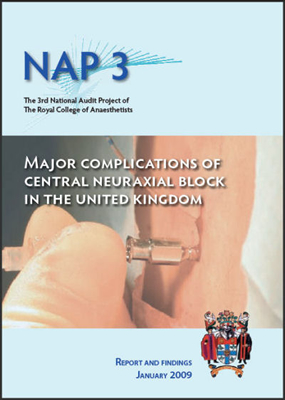In 2009, the Royal College of Anaesthetists published its 3rd National Audit Project (NAP3), the National Audit of Major Complications of Central Neuraxial Block in the United Kingdom. The purpose of this complex and impressive prospective audit was to determine the incidence of those complications of central neural blockade leading to permanent patient harm.
An initial census phase gave a denominator figure of around 700 000 central neural blocks (CNB) in the UK each year. These comprise:
46% spinals, 41% epidurals, 6% combined spinal and epidural (CSE), 7% caudal, or, viewed alternately: 45% obstetric, 43% perioperative, 6% chronic pain, 3% paediatric.
In the subsequent year of data collection, 84 major complications were reported. In the analysis, two risk assessments were made: one ‘pessimistic’, one ‘optimistic’ according to the likelihood of a CNB being causative.
The incidence of permanent injury was 1:23 500 – 1:50 500 (pessimistic – optimistic) for all CNBs. There was considerable inter-CNB variation though: for instance, the risk after postoperative epidural analgesia was the highest at 1:5 700 – 1:12 200. The incidence following all CNBs of paraplegia or death was 1:54 500 – 1:141 500, and the risk of death alone <1:100 000 – <1:200 000.
Postoperative epidural carried the highest risk and CSE accounted for a disproportionately high number of complications. The results must be interpreted cautiously, as the patient groups were of course not standardised. In general however, the figures accord with estimates from comparable previous analysis.
Downloads of an executive summary and the full report are available in the Resources section.
